Formula 1 racing is a thrilling and fast-paced sport, but it can be difficult to understand all the F1 terms and jargon used by commentators and fans.
This comprehensive glossary of F1 terms will help you become an expert in no time, from understanding the different types of tires to the meaning of DRS and ERS.
The words listed below are common in the world of Formula One. Many of the terms have come about after a long history of the sport and, even though technology has moved on (such as with flags) the words are still used
The following article explains all the commonly used F1 words, which will help you understand what is happening. Read this before the race, and you can impress everyone with your knowledge of Formula One.
We have divided the dictionary of terms into words for each category.
Learn what the following terms mean and become the most knowledgeable member of your friends!
F1 Terms – Aerodynamics – Aero
Aerodynamics is the study of how air flows around objects, and it plays a crucial role in Formula 1 racing.
The shape and design of a car’s bodywork, wings, and other components are all optimized to reduce drag and increase downforce, which helps the car stick to the track and go faster through corners.
Teams use wind tunnels and computer simulations to fine-tune their aerodynamic designs, and it’s a constant battle to find the perfect balance between speed and stability.
All of the following terms relate to the aerodynamics of the F1 car.
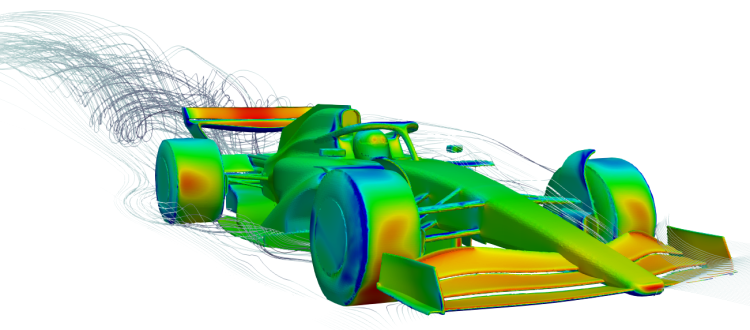
F1 Aerodynamics – Aero
Although the study of airflow (aerodynamics) is the same as that used in the aircraft industry, the goal is almost the opposite.
Both disciplines study how the parts of the device (F1 car or aircraft) interact with the different airflows in and around the car or airplane, but the goal of an aircraft aero dynamist is the create efficient lift.
An F1 racing car aero dynamist is looking to reduce drag (to make the car go faster) while reducing lift and forcing the car onto the road.
By creating downward pressure (downforce), the car can navigate corners faster while maintaining traction on the road.
The sum of the car’s aerodynamic ability is termed the car’s “Aero.”
F1 Terms – Clean air
Clean air allows following cars to stay close to the car in front, allowing optimal racing competition.
Before 2022 the car’s air produced more “dirty” turbulent air, making it very difficult for the cars behind to follow closely.
The turbulent air reduced the following car’s downforce making it more difficult to match the car’s speed in front. This made it difficult to overtake and reduced the spectator appeal of the sport.
Once the leading driver moved to the front of the pack, unless something significant happened to change his fortunes, he was safe in that position. That made the race less appealing to fans.
In 2022 the car’s front and rear wing shape changed to minimize the air spinning off from the corners of the wing and producing a wide wake of dirty air.
F1 Terms – Dirty Air
The dirty air that an F1 car produces is turbulent and is not calm. The “dirtier” the air, the harder it is for the following drivers to compete.
F1 Terms – Downforce
Downforce is the result of the aerodynamic characteristics of the car.
It is a double edged sword. A car with high downforce is faster through the corners but will generate excess drag down the straights which slows the speed capability of the car.
F1 Terms – Ground Effect Aerodynamics
From 2022 the F1 cars were designed to use the “Ground Effect” and increase downforce.
The aerodynamics uses the floor of the car, the front wing, and sidepod designs to create a vacuum under the car, improving grip. The faster the car travels, the greater the vacuum.
F1 Terms – Porpoising
Many of the 2022 F1 cars struggled with the porpoising that resulted from these designs. Porpoising is a bouncing action due to flaws in the car’s Ground Effect Aerodynamics.
The ground effect comes into play when the car speeds up sufficiently so that the floor’s aerodynamic design creates a vacuum comes into effect.
As the car’s speed continues to increase or the road surface has bumps, the ground effect system suffers an “aerodynamic stall” (similar to when the angle of attack on an aircraft wing prevents it from creating lift.)
The result is that the suction disappears, and the car “bounces” up. The cycle repeats.
F1 Aerodynamics – Drag
F1 Terms: Drag defines the resistance caused by the air the car has to pass through.
The team engineers actively work to reduce the car’s drag, because it reduces the available top speed.
When they remove drag, downforce decreases. This compromises the car’s ability to quickly go around corners. The final drag coefficient is a balance between high downforce (to get through the corners) and low downforce for maximum speed on the straight.
Most teams use various wings to overcome these factors at different tracks with unique characteristics.
F1 Aerodynamics – DRS (Drag Reduction System)
DRS, or Drag Reduction System, is a feature introduced in Formula 1 in 2011 to increase overtaking opportunities.
It works by reducing the drag on the car, allowing it to go faster in a straight line. When a driver is within one second of the car in front of them, they can activate DRS on a designated section of the track.
This opens a flap on the rear wing, reducing drag and increasing speed. However, DRS can only be used a certain number of times during a race, and is disabled if the driver is within one second of the car behind them.
Depending on where in the circuit the DRS zones are located, it can increase the speed by 0-12 km/h (6.2-7.5 mph). This makes overtaking easier and reduces some of the impacts of the dirty air the car produces in front.
F1 Terms – F1 Cars
All of the following terms relate to the F1 Cars.
F1 Terms – Airbox

The airbox installed on an F1 car is located above the cockpit, behind the driver’s head, and funnels the cooling air into the engine bay, where it prevents the engine from overheating.
It also generates cooling air which makes the engine more efficient.
F1 Terms – Cockpit
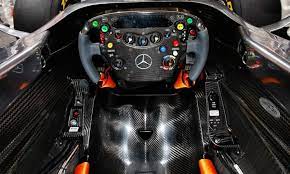
F1 Terms: The cockpit is the section of an F1 car where the driver sits.
The cockpit is a strong tub that protects the driver from impact. It has saved many of the drivers’ lives.
F1 Terms – HALO
The HALO is one of the most successful safety devices introduced in F1.
F1 Terms – The HALO system covers the open cockpit top. It protects the driver in a rollover or when something hits the car from above. HALOs take their name from their shape, which looks like an angel’s HALO – a semicircular design around the top of the cockpit.
The system was first introduced in the 2018 season to a chorus of criticism from the drivers claiming it would inhibit visibility.
The HALO has been directly responsible for saving the lives of several drivers.
F1 Terms – HANS device

HANS stands for
- Head (H)
- And (A)
- Neck (N)
- Support (S)
The devices, introduced in 2003, rest on the driver’s shoulders and clip onto the helmet.
HANS prevents sudden movements of the driver’s head and neck during an impact. By doing so, they have played a significant role in reducing brain injuries to drivers.
F1 Terms – Kevlar
F1 Terms: Kevlar is a lightweight bulletproof material. Personnel exposed to danger use it.
The Air France Concorde crashed after running over a sharp piece of metal that flew up and punctured the gas tanks causing the fire that brought it down. The remaining Concordes used Kevlar to prevent the gas tanks from rupturing again.
Kevlar makes up the major structural material in an F1 car. It provides exceptional strength while being lightweight.
F1 Terms – “Box, Box”
One of the F1 Terms that you will hear repeatedly during a race is “Box, Box.”
When a team calls the driver into the pits for a tire change, rectify a mechanical defect, to serve a penalty, or to withdraw the car from the race, they use the words “Box, Box” when talking to the driver.
They use the word “Box” because it is a phonetically precise word.
F1 Terms – F1 Circuit
All of the following terms relate to the F1 circuits.
F1 Terms – Apex
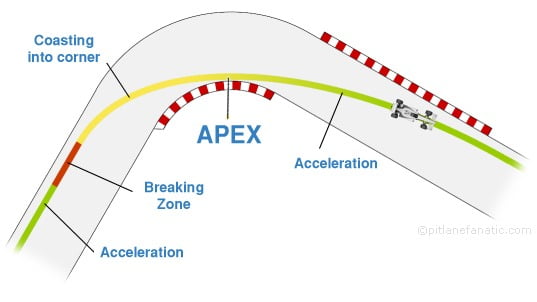
The apex is the point on a racing track corner where the car is closest to the inside of a turn. It’s the point where the car’s trajectory changes from turning in to turning out, and it’s crucial to hit the apex at the right speed and angle in order to carry maximum speed through the turn.
Drivers will often use markers on the track or reference points on the car to help them hit the apex consistently.
This has two benefits for the cars.
- It reduces wear on the tires
- The car travels through the corner faster, reducing lap times.
F1 Circuit – Chicane
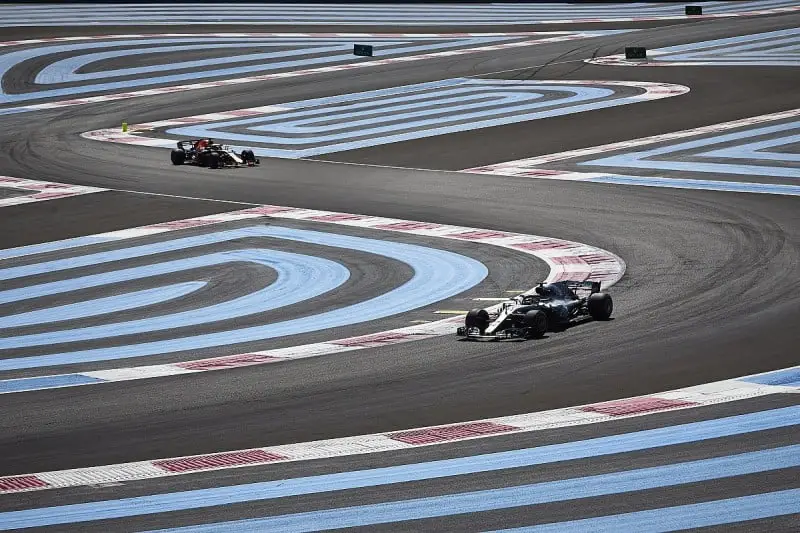
A chicane is a sequence of tight, alternating corners often taken at a lower speed. Most older circuits had these introduced in the 1990s to help slow cars down before a high-speed corner.
F1 Terms – Paddock
The paddock is where the teams are located for the race weekend.
It normally consists of the team’s motorhomes, technical staff, and media areas.
F1 Circuit – Parc Fermé
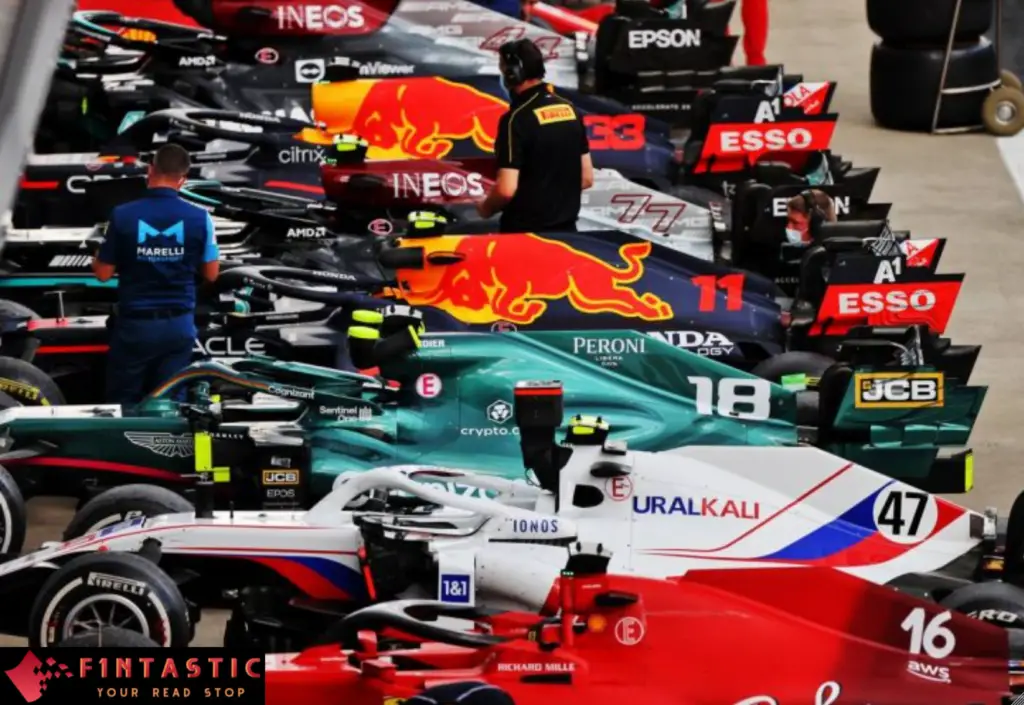
The literal translation of Parc Fermé has two meanings as follows.
- A closed park with restricted entry.
- In motor racing, it is a secure car park. Teams leave the competing cars there after qualifying.
F1 Circuit – Pits
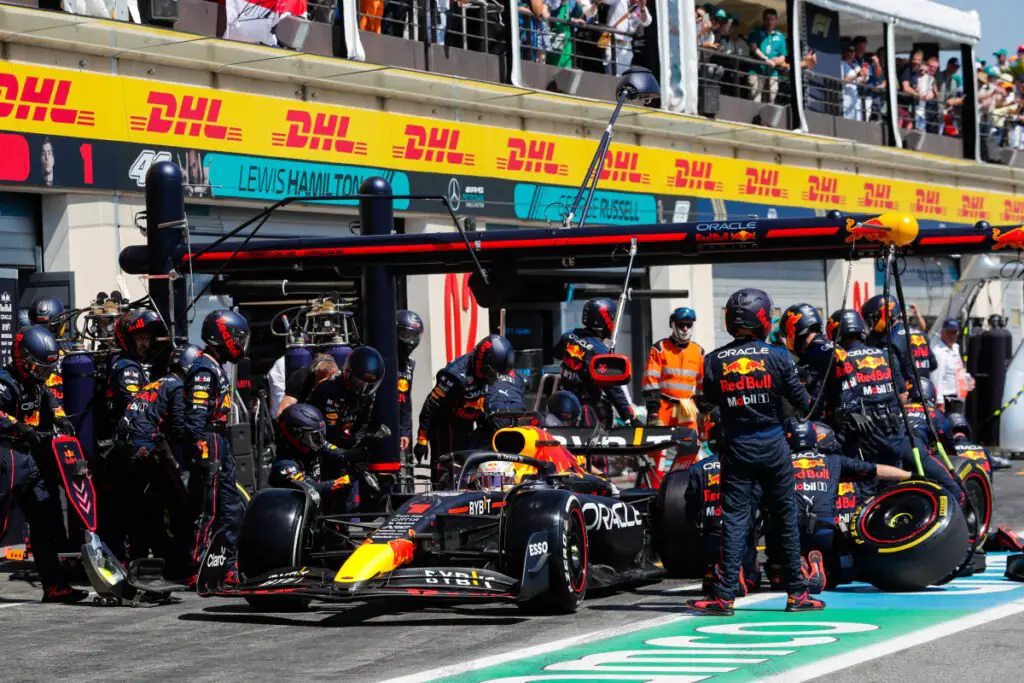
The pits are the designated garages alongside the track where teams work on the cars.
The words “Box, Box” make the driver turn into the pitlane, which leads to the pits.
F1 Circuit – Podium
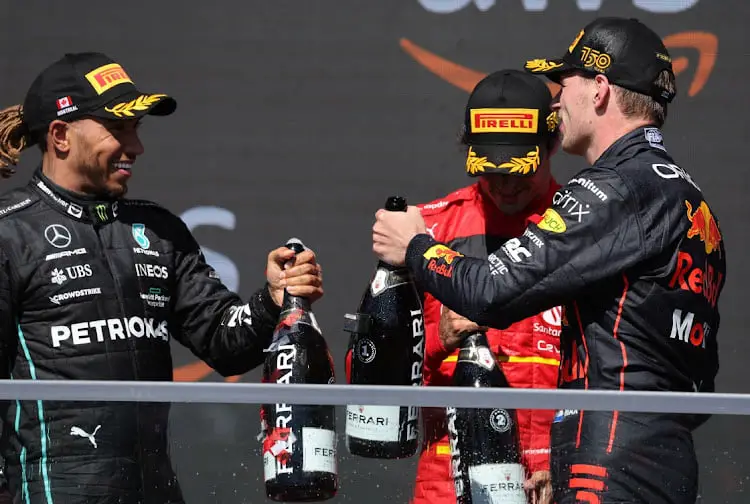
The reason why most drivers race in Formula 1 is to end up on the podium.
They celebrate the 1st, 2nd, and 3rd drivers on the podium. They award trophies, drink champagne, and give victory speeches.
F1 Circuit – Pole position
The F1 driver who qualifies with the fastest time starts the race from the front of the grid ahead of all the other drivers – pole position.
F1 Terms – F1 Drivers
All of the following terms relate to the F1 drivers.
F1 Drivers – Grand Chelem
A Grand Slam in F1, also known as a “Grand Chelem,” is incredibly difficult to achieve.
To achieve a Grand Chelem, the driver must achieve the following four accomplishments in the same race weekend.
- Pole position on the starting grid.
- Lead every lap of the race.
- Win the race.
- Set the fastest lap of the race.
These are almost impossible goals to reach, and it is a rare occurrence in F1.
The following drivers achieved a Grand Chelem.
| Driver | Number Achieved |
|---|---|
| Jim Clark | 6 |
| Lewis Hamilton | 6 |
| Alberto Ascari | 5 |
| Michael Schumacher | 5 |
| Sebastian Vettel | 4 |
| Juan Manuel Fangio | 2 |
| Mika Häkkinen | 2 |
| Nico Rosberg | 2 |
| Jack Brabham | 2 |
| Niki Lauda | 1 |
| Stirling Moss | 1 |
| Gilles Villeneuve | 1 |
| Damon Hill | 1 |
| Fernando Alonso | 1 |
| Max Verstappen | 1 |
F1 Driver – Nomex
All drivers wear racing suits, underwear, gloves, and shoes made from Nomex.
The protection material increases the length of time a driver can survive a fire.
F1 Driver – Overcut
Overcut is a strategy that teams use when it is difficult to overtake.
The team running behind waits for the front runner to pit and then increases speed to as fast as the existing tires allow in the hope that when they pit, they will have put enough distance between them and the other team. By doing so, they hope they come out of the pit lane in front.
By pitting later, the team which has overcut the other hopes that their car’s tires will have more life left on them later in the race, and as the other car is slowing because of tire wear, the team which overcuts can then overtake.
Teams use overcutting when they have a top-speed advantage over the other teams.
F1 Driver – Undercut
This is the opposite of the overcut and allows the undercutting team to overtake the lead by pitting early and racing with newer tires than the competition.
Teams attempt an undercut to achieve an advantage in track position, particularly in circuits that are difficult to overtake.
F1 Driver – Oversteer
Oversteer occurs when the driver attempts to turn, and the car’s rear starts sliding out.
To control an oversteer situation, the driver applies the opposite steering lock to try and bring the rear end back into the line of travel. Too much opposite lock causes the car to swing wildly in the opposite direction, making it uncontrollable.
F1 Driver – Retirement
A driver forced to stop before the end of the race due to a mechanical failure, accident, or a medical issue retires.
F1 Driver – Understeer
Understeer is the opposite of oversteer. Tires have insufficient grip, or corners are approached too fast and so carry the car in the direction it approached the corner.
Understeer causes the driver to turn wide or end up in the sand trap on the outside edge of the corner.
F1 Terms – F1 Engines
All of the following terms relate to the F1 engines
F1 Engines – ERS
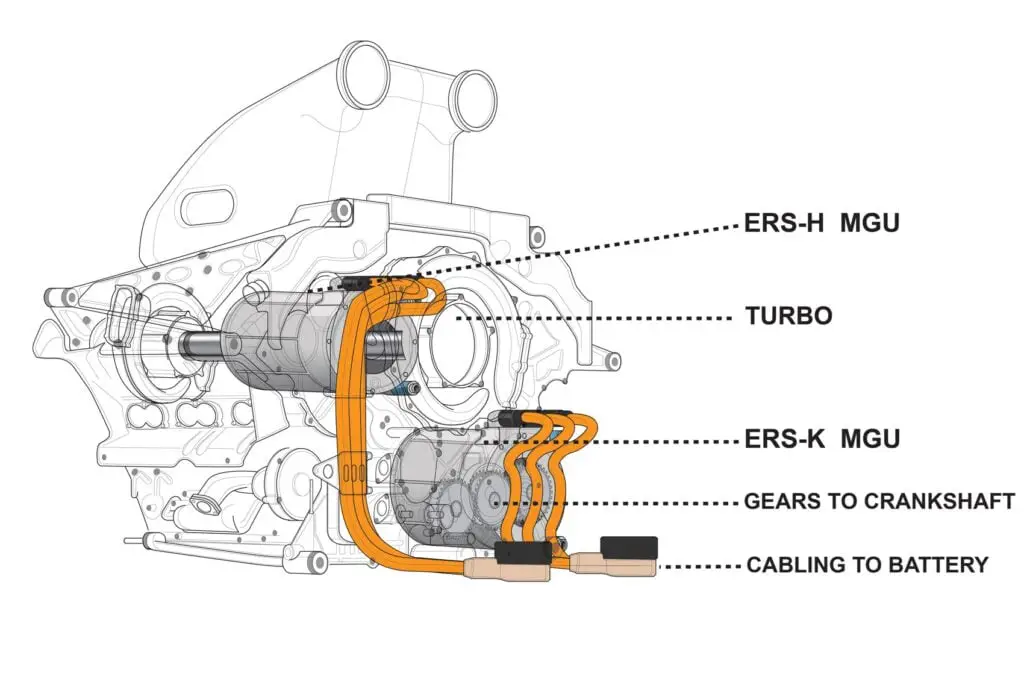
ERS, or Energy Recovery System, is a feature introduced in Formula 1 in 2014 to increase the efficiency of the cars and reduce fuel consumption.
It works by recovering kinetic (heat) energy that is normally lost during braking and stores it in a battery. This stored energy is then used to power an electric motor, providing an extra boost of power to the car.
The ERS is made up of two components: the MGU-K (Motor Generator Unit – Kinetic) and the MGU-H (Motor Generator Unit – Heat). The MGU-K recovers energy from braking, while the MGU-H recovers energy from the exhaust gases.
The use of ERS is limited during a race, and drivers must manage their usage carefully to ensure they have enough energy to complete the race.
F1 Terms – F1 Flags
The following terms describe the flags used in an F1 race.
F1 Flags – Green Flag
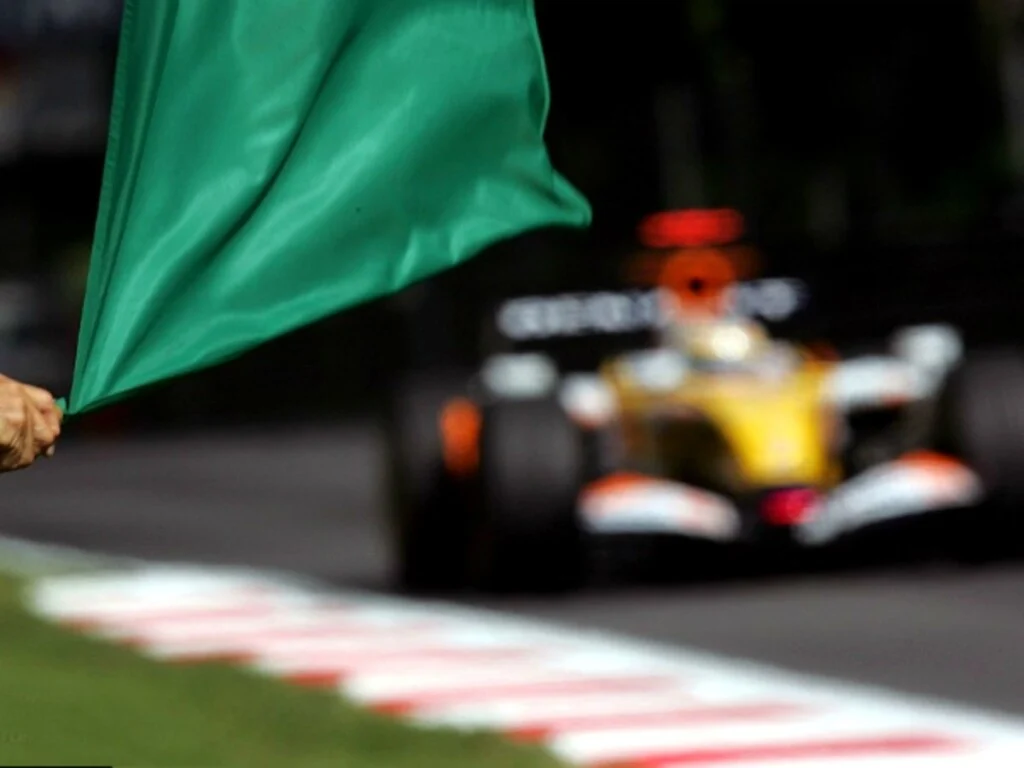
A green flag shows the driver the yellow flags are not in force.
F1 Flags – Red Flags
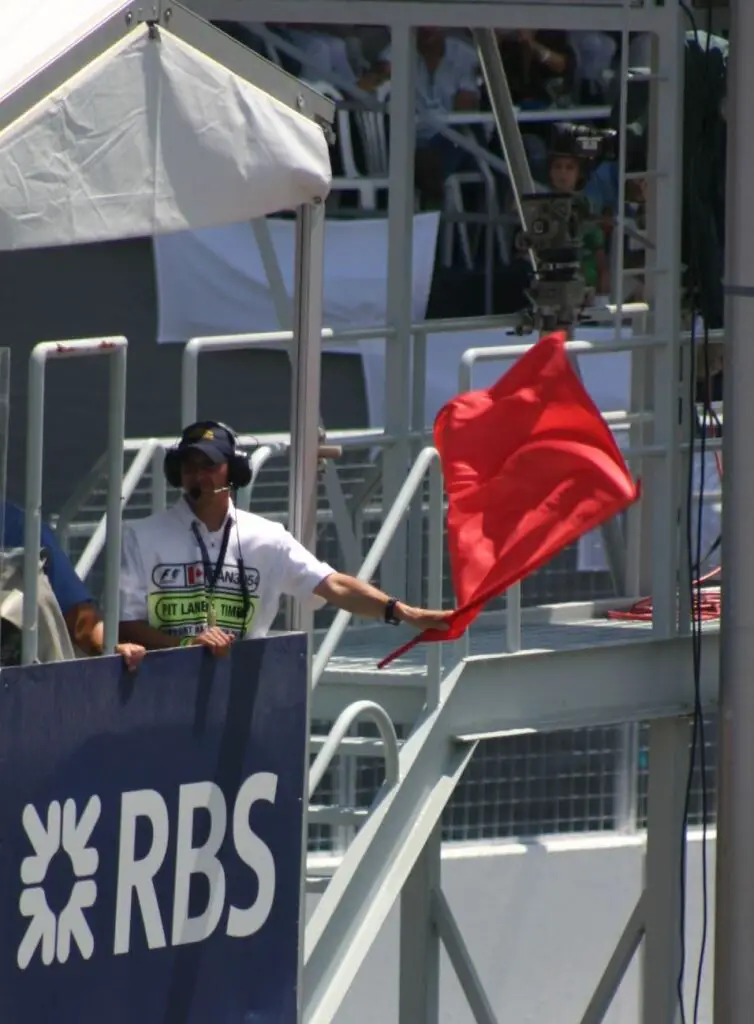
They use a red flag to warn of a serious incident. It stops the session until further notice.
F1 Flags – Yellow Flag
When they display a yellow flag, a hazard is on track, and drivers must reduce their speed.
While they wave the yellow flag, drivers cannot overtake each other.
F1 Flags – Yellow And Red Vertically Striped Flag

They display this flag under one of two conditions.
- If the flag is held horizontally and kept still, the track is slippery due to oil, water, or loose debris.
- Waving it from side to side means a small animal has got onto the track.
F1 Flags – SC Flag
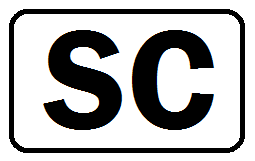
An SC flag indicates the safety car is deployed, and overtaking is not allowed.
F1 Flags – Blue Flag
A blue flag is displayed if one of the drivers is lapped by a faster car. This instructs the lapped driver to give way to the approaching lapping driver.
F1 Flags – Black Flag
A black flag shows the F1 driver that he has been disqualified.
F1 Flags – Black Flag With Orange Circle
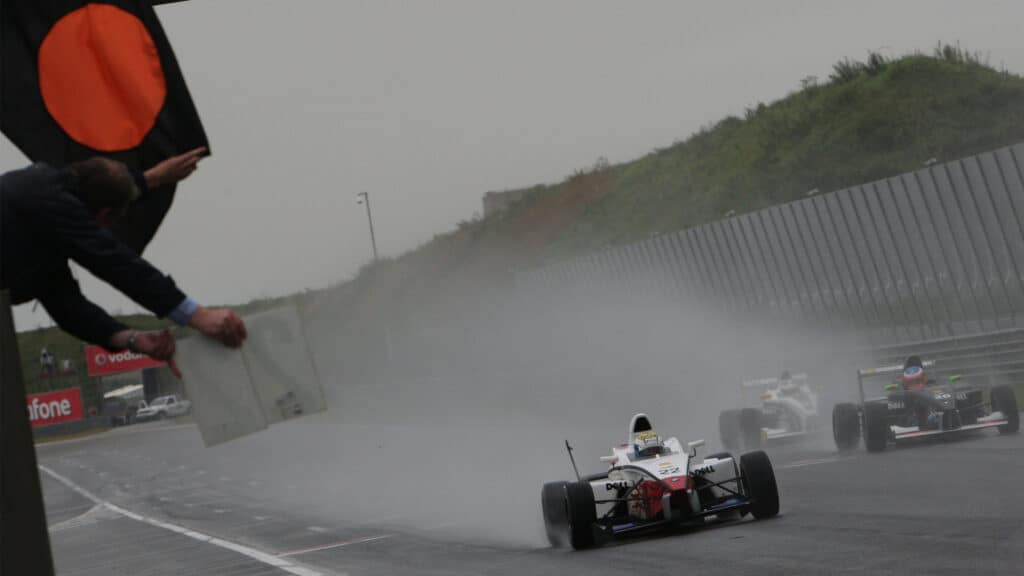
A black flag indicates to a driver that his car has been damaged and he must return to the pits.
F1 Flags – Flag With Black And White Triangle
This flag warns drivers of unsportsmanlike behavior and may follow a black flag.
F1 Flags – Checkered Flag
The checkered flag indicates the end of the race or other session.
F1 Terms – F1 Rules And Regulations
The following section describes the words used in connection with the F1 rules.
F1 Rules – FIA
The Federation Internationale de l’Automobile (FIA) is the governing body of most motorsport activities worldwide.
F1 falls under the ambit of the FIA.
F1 Rules – Cost cap
Until the 2021 season there were no limitations on the amount of money teams could spend on designing, building, or maintaining a car.
Teams with deeper financial pockets invested substantially more than other team and the results were skewed in their favor.
From 2021 and onwards an increasingly strict financial limit has been imposed on how much the teams can spend. The intent is that is teams invest the same amount the cars will be similar from a competitive perspective.
How Much Is The Cost Cap?
Until the 2021 season, there were no limitations on how much teams could spend designing, building, or maintaining a car.
Teams with deeper financial pockets invested substantially more than others, and the results were skewed in their favor.
From 2021 onwards, an increasingly strict financial limit has been imposed on how much the teams can spend. The intent is that if teams invest the same amount, the cars will be similar from a competitive perspective.
How Much Is The Cost Cap?
The cost cap has developed as follows.
- The 2021 budget cap was $175m.
- In 2022 it reduced to $145m.
- In 2022 it reduced to $140m.
- In 2023 it reduced to $136.1m.
So far that has not been the effect, and teams like Red Bull still outclass and outperform the rest of the pack. Red Bull exceeded the cost cap in 2021 and faced a $7 million fine and 10% reduced time in the air tunnel.)
Expenses that fall within the cost cap include:
- All of the parts that make up a car.
- All the devices that are required to run the car.
- The majority of the team personnel.
- All of the equipment is used in the garage.
- All of the transport costs.
Expenses not governed by the cost include the following.
- The F1 driver salaries are excluded from the cost cap.
- The salaries of the three highest-paid staff members in the team.
- The team’s travel costs.
- The Advertising and marketing budget.
- Property and legal costs.
- All entry and license fees.
- Any non-F1 or road car activities
- Parental and sick leave payments
- Employee bonuses and staff medical benefits
F1 Rules – Installation lap
The installation lap is the first lap driver’s turn at the circuit.
F1 Rules – Grid position
Grid position refers to the starting position of a driver on the grid at the beginning of a race.
The grid is determined by the results of the qualifying session, with the fastest driver starting in pole position (at front) and the rest of the drivers lining up behind them in order of their qualifying times.
Grid position is important in Formula 1 as it can greatly affect a driver’s chances of winning the race. Drivers who start at the front of the grid have a better chance of avoiding accidents and overtaking slower cars, while those at the back of the grid may struggle to make up positions and could be caught up in incidents.
F1 Rules – Qualifying
In the qualifying session, the drivers achieve their starting position on the grid. The driver who qualifies with the fastest time ends up in the front of the grid.
The driver who qualifies in the slowest time ends up in position 20 on the grid.
On standard format qualifications, there are three sessions.
Qualifying Session One
It eliminates the slowest five drivers, the rear five cars on the grid (in the order of their qualifying.)
Qualifying Session Two
The remaining fifteen drivers enter Qualifying Session Two.
It eliminates the slowest five drivers and ends up in position eleven to fifteen on the grid (in the order of their qualifying.)
Qualifying Session Three
In the final session, the fastest ten cars race. The fastest driver occupies the pole position on the grid, and the slowest is the tenth.
Sprint Weekends
The 2023 Azerbaijan F1 Grand Prix introduces a completely new sprit format.
Friday starts with the first (and only) free practice events of the weekend.
The afternoon is taken up with a qualifying session, which will decide the starting position for the main race on Sunday.
In this format Saturday is a full race day completely independent of the rest of the weekend.
Saturday morning features the new format “sprint shootout” qualifying session for the Saturday afternoon Sprint event.
Saturday afternoon is the full sprint event. The starting grid of the afternoons sprint event is decided by the results of the sprint shootout. The top eight drivers win points which accumulate to the championship points.
The outcome of the Saturday Sprint has no bearing on the Sunay race
This is obviously intended to please spectators and viewers, however it is going to be very difficult for the teams, who lose two free practice events.
The new format means that all the F1 teams will not be able to gather the data they normally compile for long runs. This will compromise their tire strategies.
F1 Rules – Free Practice
Before the sprint race profile of qualifying was introduced, the teams had two sessions on the preceding Friday and one on Saturday to practice.
They used this time for a variety of purposes, including.
- Testing new systems and modifications on the car.
- The optimized setup for that track.
- To develop an understanding of how the tires hold up on the track.
- To help them develop a race strategy and decide how many pit stops will be optimum.
- To allow junior drivers to test the car.
When the sprint session is incorporated, the sessions are changed as follows
- Practice One on The preceding Friday
- The Sprint Race
- Practice Two on Saturday
- Practice Three on Saturday
- The main race is on Sunday
F1 Rules – Jump Start
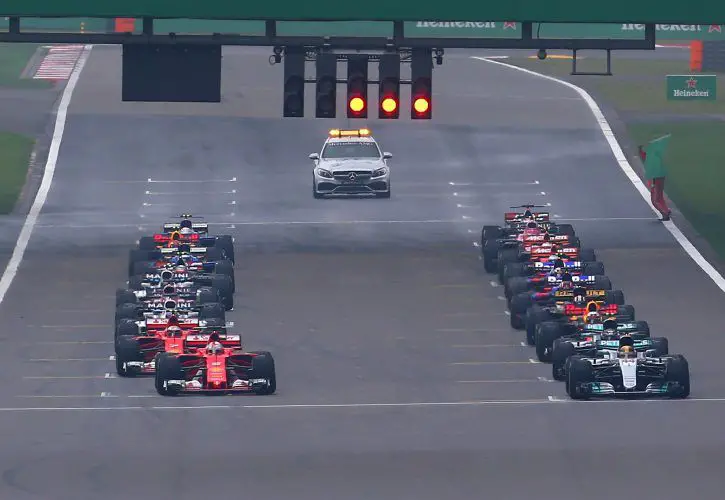
If a driver moves out of his grid box before the green light start is given, he commits an offense and receives a time penalty.
F1 Rules – Safety Car
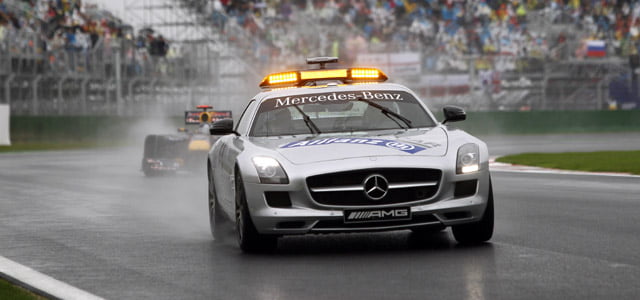
The safety car is a vehicle (currently a Mercedes or Aston Martin) brought out to lead the race at a slower speed than would normally be driven by the F1 cars.
Safety cars bunch up and control the pace of all the F1 cars when an incident on track requires the race to be neutralized and cars to be slowed.
F1 Terms – F1 Tires
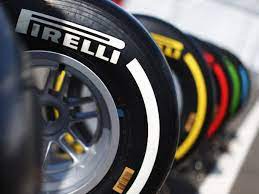
The following section explains the terms used in connection with F1 tires.
F1 Tires – Aquaplaning
When a car (F1 or other) travels onto a thin patch of water, there is just enough force to lift the tires off the road surface.
This results in steering and braking control issues (similar to running over ice)
The slick tires used by F1 in dry weather have no grooves which displace the water and are therefore very prone to Aquaplaning.
This is why the wet weather tires used by F1 have a defined tread that reduces the potential of aquaplaning.
F1 Tires – Blistering

If the inside of the tire heats up faster than the outside, air pockets will develop. These expand and eventually burst out, removing part of the tread belt. They call this blistering.
F1 Tires – Graining
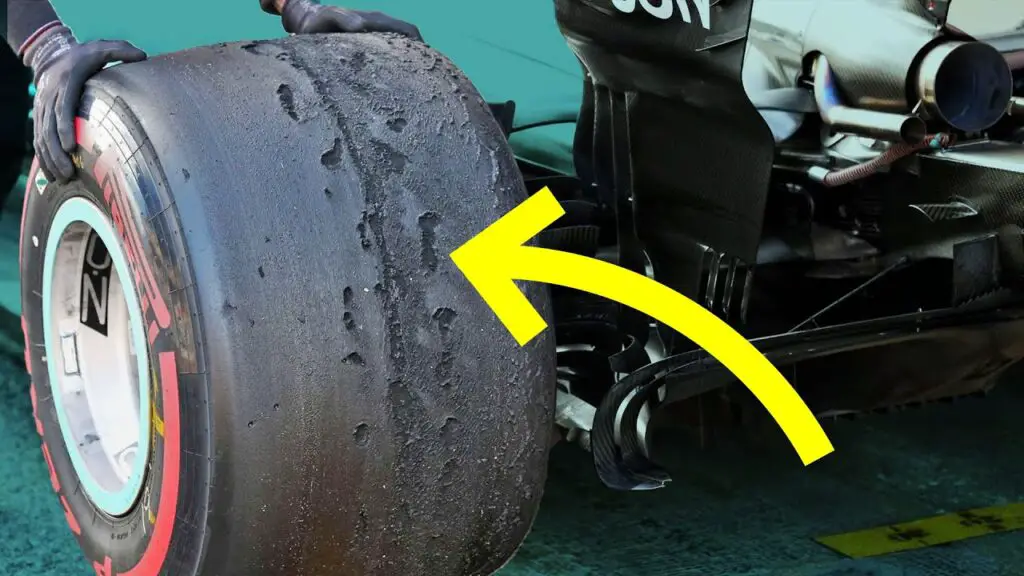
Graining is caused because the tire’s surface temperature is not raised to the optimal range.
This happens when the outer surface of the rubber ends up heating substantially more than the inner parts of the tire.
The tire’s hot “melty” surface deforms and wears under high cornering loads.
An F1 car cornered at high speeds experiences a very high lateral (sideways) load. This “grabs” the hot, soft rubber, and the rubber begins to deform with little “peaks” and “valleys” appearing on the surface.
The tread develops a texture called graining.
The uneven surface of a tire reduces, making the car less stable and responsive around the track.
F1 Tires – Marbling
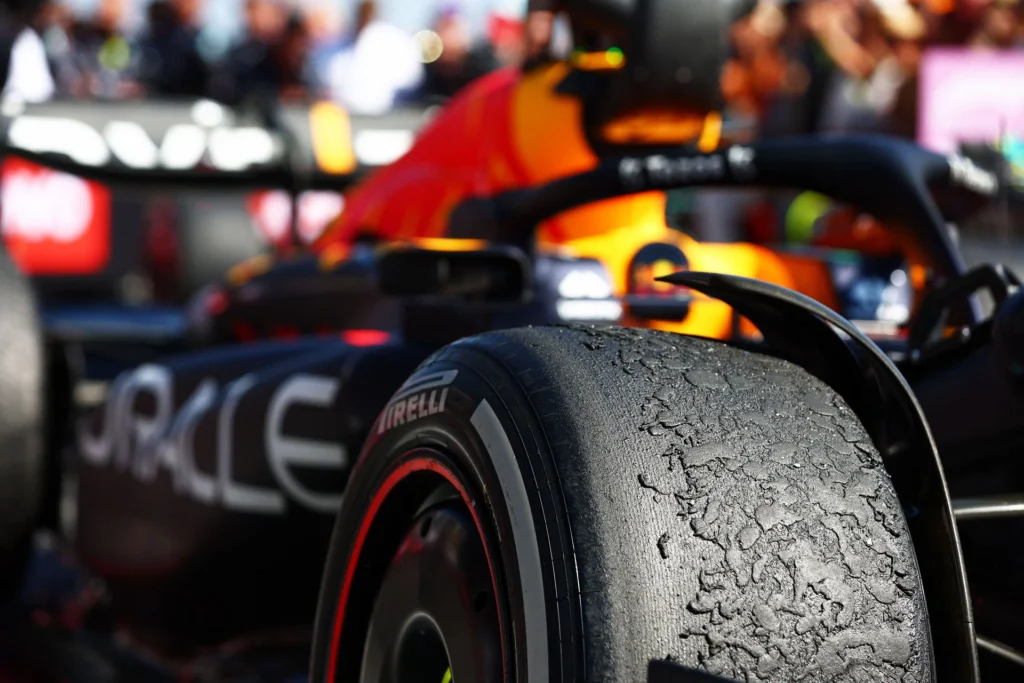
Many of the “peaks” of the tire are torn off and end up on the track (as opposed to the tire.)
They tend to fall off on the edge of the racing line – particularly in corners with high lateral loads. The debris is called marbles.
When a driver moves off the racing line (deliberately or by accident), the tires slide over the marbles on the road. The result is that the car loses grip (traction), and lap times are severely affected.
F1 Tires – Flat spot

A flat spot is damage to the F1 car’s tire, which is normally caused by one of the wheels being over-braked and skidding. This is termed “Lock Up.”
As the stopped car slides along the pavement, the friction causes a flat area to develop.
When the tire starts moving again, the flat part is unbalanced and causes the tire to bounce up and down.
This causes severe vibration and may require the driver to return to the pits (box) to change the tires.
F1 Tires – Grip
The tire’s grip is the amount of “stick” it exerts on the road. The grip is determined by several different factors, including the following.
F1 Tires – Lock-up
The term lock up means one or more F1 tire is over braked and stops rotating.
When a tire locks up, it generally leaves a flat spot, affecting the subsequent handling of the F1 car.
The Tire Heat
Depending on the tire compound, an F1 tire’s optimal temperature range varies between 212° – 290°F(100°-145°C), which at 356°F (180 °C) is close to the melting point of pure rubber.
The higher the heat, the faster the tire wears down, which reduces grip.
The Age And Wear Of The Tire
The more a tire is driven, the less grip it can produce. This is different for the different categories of tires and the circuit.
The Weather
The grip reduces substantially in wet conditions. When the track is too wet, the teams switch to the following tires.
- First Intermediate.
- And then wet tires



[…] F1 Terms: List of Racing Terms […]
[…] Clean air is the undisturbed and smooth airflow that a car experiences when it is not following another car. […]
[…] the power of DRS, or Drag Recovery System, a device that can boost your speed by up to 12 km/h on the straights and […]
[…] F1 Terms: List of Racing Terms […]
[…] car’s braking and exhaust. The ERS consists of two components: the motor generator unit-kinetic (MGU-K) and the motor generator unit-heat […]
[…] Grand Prix result was particularly credible because the DRS (Drag Reduction System) was not working. Despite this, Fernando beat Carlos Sainz, Lewis Hamilton, and Lance […]
[…] 2023 race weekend starts on Friday, 28 April. This is the first of a completely new sprint format in the 2023 calendar. Baku GP time follows the schedule […]